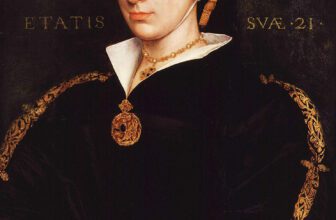The Mad Queen Who Was Never Truly Heard
In the grand halls of Spanish history, few figures are as tragic, enigmatic, and misunderstood as Joanna of Castile, known to history by a moniker that has haunted her legacy: Juana la Loca or Joanna the Mad. Was she truly mad, or was she a victim of power, manipulation, and the merciless tide of politics that swept through 15th and 16th-century Europe?
The story of Joanna is one of love and betrayal, of political games and emotional turmoil. It’s a tale steeped in royal intrigue, where mental illness, or the appearance of it, became a powerful tool of imprisonment.
A Royal Birth in a Golden Age
Joanna of Castile was born on November 6, 1479, in Toledo, Spain, to Queen Isabella I of Castile and King Ferdinand II of Aragon, the Catholic Monarchs who united Spain and sponsored Christopher Columbus’s voyage to the New World. From birth, Joanna was a royal of unmatched pedigree, a member of the Trastámara dynasty, and a child of two of the most powerful monarchs in European history.
She was not initially destined to rule. As the third child of Isabella and Ferdinand, she was behind her older siblings Isabella, John, and Maria in the line of succession. Like many royal daughters of the time, her early life was shaped not by preparation for rule, but by plans for a strategic marriage.
Marriage to Philip the Handsome
In 1496, at the age of sixteen, Joanna was married to Philip the Handsome, son of Maximilian I, the Holy Roman Emperor, and ruler of the Burgundian Netherlands. The marriage was a political alliance intended to strengthen ties between Spain and the Habsburg Empire, a powerful force in European politics.
But against all odds for a royal match, Joanna and Philip fell in love. Accounts from the time describe a passionate relationship that started with immediate attraction. Joanna, deeply in love with her handsome husband, became emotionally dependent on him.
However, Philip, known for his good looks and charm, was not faithful. His frequent affairs caused Joanna tremendous distress. Her jealousy was intense, and some reports claim she reacted violently, including pulling the hair of one of his mistresses and locking up other women who she suspected of seducing him.
This obsessive love and her emotional volatility were some of the earliest signs of behavior later labeled as “madness.” But were these signs of mental illness, or the understandable reactions of a deeply hurt woman in a time where women had little recourse?
The Deaths That Changed Everything
Joanna’s life took a dramatic turn after a succession of deaths that decimated the Castilian line of succession.
Her brother Prince John, the heir to the thrones of Castile and Aragon, died suddenly in 1497. A year later, her older sister Isabella passed away in childbirth. Her nephew Miguel, who could have inherited both the Spanish and Portuguese thrones, died in 1500.
Suddenly, Joanna was the heir to the united crowns of Castile and Aragon.
This elevation brought both power and peril. Joanna and Philip were now central figures in the political theater of Europe. However, her rise coincided with Philip’s growing ambition, and a slow unraveling of her mental and emotional health.
The Tragedy of Power and the Descent into Isolation
In 1504, Joanna’s mother, Queen Isabella, died. According to Isabella’s will, Joanna became Queen of Castile, with Ferdinand acting as regent in her name.
But Ferdinand and Philip quickly clashed over who should truly rule. Philip wanted control over Castile, while Ferdinand wanted to maintain his authority. Joanna, caught between her father and her husband, struggled to assert her sovereignty.
By now, reports of her erratic behavior began circulating widely. These included:
Deep depressions and long periods of silence.
Obsessive jealousy and wild accusations.
Refusals to eat or sleep properly.
Rumors that she was unfit to rule.
But one must ask, were these true signs of madness? Or were they politically convenient narratives?
Philip used these accounts to declare her mentally unfit. In 1506, he managed to have her sidelined and declared Queen in name only, with himself as King of Castile.
Yet fate had another cruel twist. That same year, Philip died suddenly at the age of 28, likely from typhoid fever.
What happened next cemented Joanna’s infamous reputation.
The Macabre Procession of the Dead
Upon Philip’s death, Joanna was said to be overcome by grief to the point of madness. She reportedly refused to be separated from his corpse, even traveling with it through the Castilian countryside for months. She opened the casket at times to gaze at his body, speaking to him as if he were still alive.
Whether these stories are exaggerated or not, they became the foundation of her legend. The image of a grief-stricken queen, wandering the night with her dead husband, etched her into history as a madwoman.
But historians now suggest this procession was partly symbolic and partly a strategic move. By keeping Philip’s body in public view, Joanna may have hoped to garner loyalty and support during a time of political chaos.
Imprisonment and the Loss of Freedom
After Philip’s death, Joanna’s father Ferdinand took over the regency. He wasted no time in declaring her unfit to rule. In 1509, he ordered her confinement to the Royal Palace of Tordesillas, where she would spend the next 46 years of her life.
Her youngest daughter Catherine of Austria was confined with her, and together they lived a secluded life. Joanna was rarely allowed visitors, and her conditions were often harsh. There were periods of neglect, strict surveillance, and even abuse, especially under her wardens and during the reign of her son Charles V, the future Holy Roman Emperor.
Throughout this time, Joanna remained Queen of Castile in title, but never again held real power.
What Was Her Mental Illness?
Modern historians and psychiatrists have speculated on what truly ailed Joanna.
Possibilities include:
Schizophrenia: Some suggest delusions and disorganized thought patterns.
Bipolar disorder: Her intense emotional swings and depressive episodes fit this diagnosis.
Severe depression: Triggered by loss, betrayal, and isolation.
Borderline personality disorder: Intense fear of abandonment, impulsivity, and volatile relationships.
Postpartum psychosis: Given she had six children in quick succession.
However, others argue that she may not have suffered from any clinical mental illness at all. Rather, she was a highly emotional, politically marginalized woman in a patriarchal society that labeled resistance or distress as insanity.
Her “madness” may have been manipulated or fabricated by her father and later her son, Charles V, to remove her from power.
A Forgotten Queen, A Complex Legacy
Joanna died on April 12, 1555, after nearly five decades of confinement. She was 75 years old.
In her lifetime, she was:
The daughter of Isabella and Ferdinand.
The wife of Philip the Handsome.
The mother of Charles V, one of the most powerful emperors in European history.
And yet, she was silenced, imprisoned, and ultimately erased from active history, remembered more for her “madness” than her intelligence, education, or resilience.
Today, scholars and feminists have reexamined her story. In an era when women were rarely allowed emotional complexity, Joanna’s grief, passion, and resistance were weaponized against her. She has become a symbol of how mental illness can be misunderstood, and how women’s voices can be suppressed through the label of madness.
In Popular Culture and Reappraisal
Joanna’s life has inspired numerous works of fiction, opera, and film, including the Spanish movie Juana la Loca (2001), which depicts her emotional torment and political imprisonment with dramatic intensity.
More recent biographies and academic studies, such as Bethany Aram’s “Juana the Mad: Sovereignty and Dynasty in Renaissance Europe”, aim to reclaim her story from myth and madness. They reveal a complex figure: not just a queen who lost her mind, but a woman who was systematically deprived of power, despite being the legitimate ruler of one of the most powerful kingdoms of her time.
Perhaps Joanna of Castile did suffer from genuine mental illness, worsened by grief, betrayal, and political isolation. Or perhaps she was a victim of history, trapped in a web spun by powerful men who had much to gain by painting her as unstable.
What is certain is that her story deserves more than the label “the Mad Queen.”




